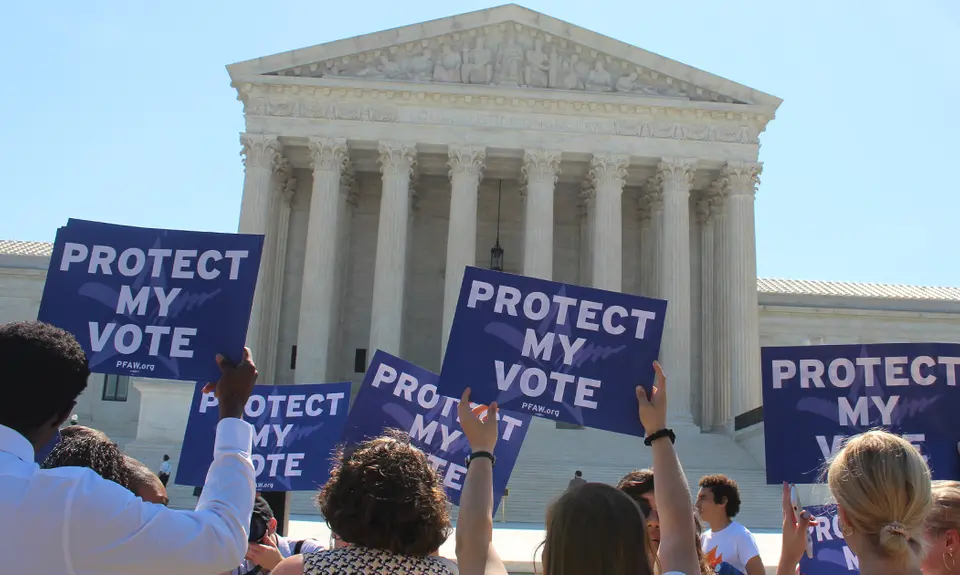Trump Justices Neil Gorsuch, Brett Kavanaugh, and Amy Coney Barrett formed a key part of a Supreme Court majority that issued an unsigned opinion that harmed minority voting rights. The decision, a “shadow docket” ruling issued without full briefing or oral argument, was in Wisconsin Legislature v. Wisconsin Elections Commission.
What Happened in Wisconsin
State officials in Wisconsin have worked on the redrawing of voting district lines for the state legislature based on the 2020 census. An impasse developed between the Republican-controlled state legislature and Democratic governor Tony Evers. The legislature wanted a map that would shrink the number of majority-minority districts from six to five. This would make it harder for minority voters to elect candidates of their choice to office. Governor Evers favored a map that would increase from six to seven the number of districts in which a majority of voters are racial minorities.
A lawsuit on the issue reached the Wisconsin Supreme Court. The court explained that new maps should make the least change possible. Given the alternatives, the court found, the governor’s map was preferable for now. He had maintained that Section 2 of the Voting Rights Act (VRA) required the addition of a majority-minority district given population changes. The court left open the possibility that this conclusion could be challenged and the maps redrawn later.
The Republican state legislature, however, wanted immediate action. It asked for US Supreme Court review. It sought an emergency order to stay the state supreme court decision.
What did the Supreme Court majority do?
In an unsigned opinion, and without full briefing and oral argument, the Court majority went even further. It granted review and reversed the Wisconsin court decision to adopt the governor’s map. It did not order the adoption of the legislature’s map, but sent the case back to the state court to approve new maps before the state’s August primaries. The majority included Trump justices Gorsuch, Kavanaugh, and Barrett.
According to the majority, the governor committed error by claiming that the VRA required the creation of another majority-minority district. The state court, they maintained, should have applied strict scrutiny to such a race-conscious plan. Specifically, it should have considered “whether a race-neutral alternative that did not add a seventh majority-black district would deny black voters equal political opportunity.” The state court could “take additional evidence” and reconsider the governor’s plan, but it had to pass the Court’s test in order to be adopted.
What did the dissent say?
Justices Sonia Sotomayor and Elena Kagan strongly dissented from what they called the majority’s “unprecedented” ruling. They criticized the majority for “summarily” reversing the state supreme court for its “failure to comply with an obligation” to use strict scrutiny that “is hazy at best.” They pointed out that the state court had adopted the Governor’s plan primarily because it was “vastly superior” on its “least change” criteria, and that all parties had agreed that some minority-majority districts were required. Under these circumstances, they went on, the majority improperly imposed the strict scrutiny requirement. Indeed, they noted, the majority points to “no precedent requiring” such an analysis.
The dissenters also noted that the majority’s “extraordinary intervention” was “unnecessary.” The state court had “rightly preserved” the ability of others to challenge the new maps on VRA or constitutional grounds. The Court should have “allowed that process to unfold.” That would have led to a complete judicial consideration and resolution of the VRA issue. Instead, the dissent concluded, the majority had “further complicat[ed]” matters with “legal confusion through a summary reversal.”
What does all this mean?
Litigation will clearly continue in Wisconsin on new state legislative districts. It remains possible that the state court will re-adopt the governor’s plan after hearing more evidence. Indeed, it’s quite possible that Justice Stephen Breyer pushed for this in the Court’s ruling and accordingly did not dissent. But given divisions on the state supreme court and the new mandate imposed by the Court majority, the chances of a new plan that harms minority voting rights have clearly increased. And this new mandate will likely harm minority voting rights in future cases.
Election law expert Rick Hasen has explained that this case sends “another signal of a conservative supermajority” of the Court “showing increasing hostility” to the VRA. Based on “skimpy briefing” and no oral argument, the majority announced a new rule concerning majority-minority districts. That rule is “hostile to minority voting rights” by making it harder to adopt such districts. In short, the majority “continues to chip away” at the VRA. It is “killing off the last major protection for minority voters from discriminatory districting plans.”
